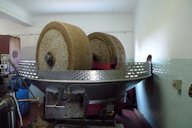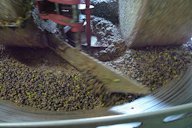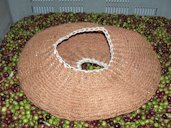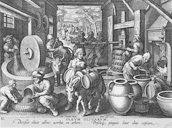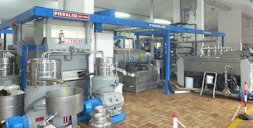| Olive Oil Extraction Process | |||||||||||||||||
|---|---|---|---|---|---|---|---|---|---|---|---|---|---|---|---|---|---|
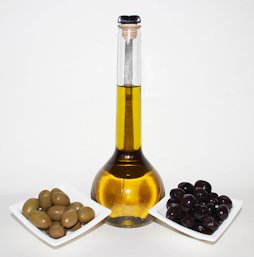 Olivenöl. Olive oil. 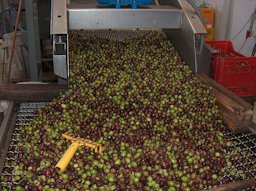 Fig. 2  Oil olive extraction: olive fruits after the washing. Sardinia, Italy. 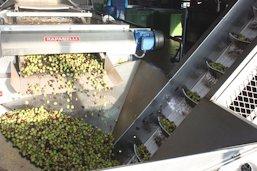 Fig. 3  Le processus de fabrication de l'huile à Château Virant, Provence Alpes Côte D'Azur 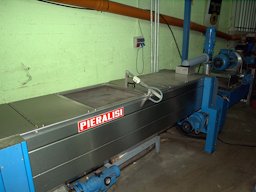 Fig. 4  A cold press olive oil machine at Saba Habib manufacturers in Kibbutz Parud in Palestine 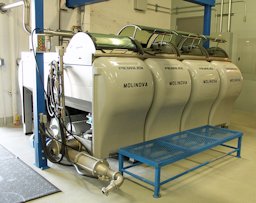 Fig. 5  Olive oil presses at Jacuzzi Family Winery, Sonoma, California Fig. 6  Olive oil presses at Jacuzzi Family Winery Fig. 7  Olive oil mill, Troghi Firenze Fig. 8  Olive oil separation with decanter technology. Thasos, Greece. Fig. 9  Oil centrifugation, Thasos, Greece. Fig. 10  Oil outflow, Thasos, Greece. 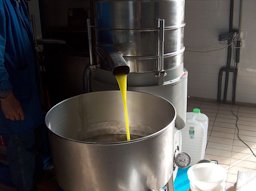 Fig. 11  Oil olive extraction: oil separated by a vertical centrifuge. Sardinia, Italy. Fig. 12  Cuves pour moulins à huile d'olives Olive oil drums, Vaucluse, France Fig. 13  Ground olives. (olive paste) 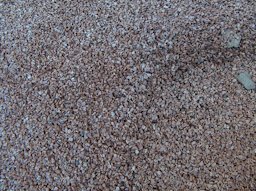 Fig. 14  Oil olive extraction: olive-stones separated from pomace. It can be used as combustible 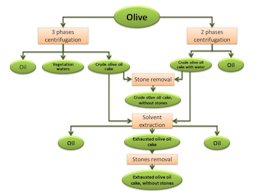 Fig. 15  Olive oil process Back to Olive Page |
Olive
oil is produced by grinding olives and extracting the oil by mechanical
or chemical means. Green olives usually produce more bitter oil, and
overripe olives can produce oil that is rancid, so for good extra
virgin olive oil care is taken to make sure the olives are perfectly
ripened. The process is generally as follows: 1. The olives are ground into paste using large millstones (traditional method) or steel drums (modern method). 2. If ground with mill stones, the olive paste generally stays under the stones for 30 to 40 minutes. A shorter grinding process may result in a more raw paste that produces less oil and has a less ripe taste, a longer process may increase oxidation of the paste and reduce the flavor. After grinding, the olive paste is spread on fiber disks, which are stacked on top of each other in a column, then placed into the press. Pressure is then applied onto the column to separate the vegetal liquid from the paste. This liquid still contains a significant amount of water. Traditionally the oil was shed from the water by gravity (oil is less dense than water). This very slow separation process has been replaced by centrifugation, which is much faster and more thorough. The centrifuges have one exit for the (heavier) watery part and one for the oil. Olive oil should not contain significant traces of vegetal water as this accelerates the process of organic degeneration by microorganisms. The separation in smaller oil mills is not always perfect, thus sometimes a small watery deposit containing organic particles can be found at the bottom of oil bottles. 3. In modern steel drum mills the grinding process takes about 20 minutes. After grinding, the paste is stirred slowly for another 20 to 30 minutes in a particular container (malaxation), where the microscopic oil drops aggregate into bigger drops, which facilitates the mechanical extraction. The paste is then pressed by centrifugation the water is thereafter separated from the oil in a second centrifugation as described before. 4. The oil produced by only physical (mechanical) means as described above is called virgin oil. Extra virgin olive oil is virgin olive oil that satisfies specific high chemical and organoleptic criteria (low free acidity, no or very little organoleptic defects). A higher grade extra virgin olive oil is mostly dependent on favourable weather conditions; a drought during the flowering phase, for example, can result in a lower quality (virgin) oil. It is worth noting that olive trees produce well every couple of years, so greater harvests occur in alternate years (the year in-between is when the tree yields less). However the quality is still dependent on the weather. 5. Sometimes the produced oil will be filtered to eliminate remaining solid particles that may reduce the shelf life of the product. Labels may indicate the fact that the oil has not been filtered, suggesting a different taste. Fresh unfiltered olive oil usually has a slightly cloudy appearance, and is therefore sometimes called cloudy olive oil. This form of olive oil used to be popular only among olive oil small scale producers but is now becoming "trendy", in line with consumer's demand for products that are perceived to be less processed. But generally, if not tasted or consumed soon after production, filtered olive oil should be preferred: "Some producers maintain that extra-virgin olive oils do not need filtration but also that filtration is detrimental to oil quality. This point of view should be considered as erroneous and probably the result of improper implementation of this operation. In fact, fine particles that are suspended in a virgin olive oil, even after the most effective centrifugal finishing, contain water and enzymes that may impair oil stability and ruin its sensory profile. [...] Filtration makes an extra-virgin olive oil more stable and also more attractive. If the suspended particles are not removed they slowly agglomerate and flocculate, forming a deposit on the bottom of the storage containers. Such a deposit continues to be at risk of enzymatic spoilage and, in the worst case, of development of anaerobic micro-organisms with further spoilage and hygienic risk. [...] It is [...] recommended that filtration be carried out as soon as possible after centrifugal separation and finishing." By-Products Olive oil extraction generates several by-products that can be used to feed animals, particularly the cakes and pomaces obtained from the extraction process, and leaves and other residues resulting from the cleaning operations. The young shoots coming out from the base of the tree can be browsed by sheep and the olives themselves can be eaten by pigs in extensive systems, such as those producing the Jamón ibérico in Spain. 6 The nature of olive oil cakes and by-products depends on the processing method (Fig.15). The products of olive oil manufacture are the following: • Crude olive oil cake, obtained by mechanical extraction. This product contains residual oil and stones. • Exhausted or defatted olive oil cake, obtained by mechanical and solvent extraction. This product contains stones and less residual oil than the previous one. • Crude olive oil cake without stones, obtained by mechanical extraction and de-stoning. This product contains residual oil and no stones. • Exhausted or defatted olive oil cake without stones, obtained by solvent extraction and de-stoning. This product contains little residual oil and no stones. • Olive oil pulp, obtained after stone removal followed by mechanical extraction. • Exhausted olive oil pulp, after stone removal and solvent extraction. • Olive oil vegetation water (“black water” or alpechin), obtained by centrifugation or sedimentation of the oil. This sugar-rich product is sirupy, black and bitter with a distinctive odour due to polyphenols and other substances. It can be (partially) dried, resulting in a molasse-like product. 6 Vegetation waters from olive milling are regarded as a severe environmental problem because of their high organic content consisting of poorly-degradable phenolic compounds that are both antimicrobial and phytotoxic (Ramos-Cormenzana et al.,1995). However, modern olive oil manufacturers usually use 2-phase centrifugation extraction processing methods that do not produce olive oil vegetation waters. 6 Olive pomace oil Olive pomace oil is the oil obtained by treating olive pomace with solvents or other physical treatments, to the exclusion of oils obtained by re esterification processes and of any mixture with oils of other kinds. It is marketed in accordance with the following designations and definitions: • Crude olive pomace oil is olive pomace oil whose characteristics correspond to those fixed for this category in the IOC standard. It is intended for refining for use for human consumption, or it is intended for technical use. 3 • Refined olive pomace oil is the oil obtained from crude olive pomace oil by refining methods which do not lead to alterations in the initial glyceridic structure. It has a free acidity, expressed as oleic acid, of not more than 0.3 grams per 100 grams and its other characteristics correspond to those fixed for this category in the IOC standard.This product may only be sold direct to the consumer if permitted in the country of retail sale. 3 • Olive pomace oil is the oil comprising the blend of refined olive pomace oil and virgin olive oils fit for consumption as they are. It has a free acidity of not more than 1 gram per 100 grams and its other characteristics correspond to those fixed for this category in the IOC standard. The country of retail sale may require a more specific designation. 3 Olive Mill Pomace Treatment: Composting as Organic Fertilizer ext link Traditional Method Traditional olive oil processing begins with crushing the olives into a paste. The purpose of the crushing is to facilitate the release of the oil from the vacuoles. Large granite stones such as the one shown in the photograph on this page were traditionally used to crush olives. In the early days, donkeys were used to pull the stone wheel around. This particular mill is motorized and also includes wiper blades, both of which are more recent additions to the traditional stone mill. 5 The next step in the process involves malaxing the paste (mixing the paste). The paste is mixed for 20–45 minutes to allow small oil droplets to combine into bigger ones. This process ensures the olives are well ground and allows the fruit enzymes to produce desirable aromas and flavors. Longer mixing times increase yield; however, they may also result in increased oxidation and decreased shelf life and quality. 5 Following milling and malaxing, the paste is spread on fiber disks, which are stacked on top of each other, then placed into a press. Traditionally, disks were made of hemp or coconut. In modern times, they are made of synthetic fibers, which can be more easily cleaned. The stacks of discs are then pressed in a hydraulic press. Pressure is applied to the disks, compacting the solid phase and percolating the liquid phases (oil and vegetation water). Pressures up to 4,000 kPa are used. Water can be used to run down the sides of the discs to increase the speed of percolation. The liquids are then separated by decantation or centrifugation. 5
Fig. 16. Oil mill granite stone. Centobuchi, Italy. Fig. 17. Working oil mill granite stone. Centobuchi, Italy. Fig. 18. Petit à petit les sections de la pile sont dressées, l'opérateur prend en sandwich la pâte d'olive entre les scourtins de coco. (Slowly the pile is built, the operator fills the olive paste between the coconut disks.) Fig. 19. La pile pleine de pâte d'olive commence à prendre de la hauteur et déjà sous son propre poids l'huile s'écoule. (As the stack gets higher, olive oil, under the weight, starts to run. Fig. 20. Selon les variétés, il faut 5 kilos d'olives pour obtenir 1 litre d'huile. (Depending on varieties, it takes 5 kilos to yield 1 liter of olive oil) General The conventional extra virgin olive oil (EVOO) extraction method consists of three main processes, which are crushing, malaxation, and centrifugation. After washing olive fruits, they are crushed using a stone-mill, hammers, disc crushers, de-stoning machines, or blades. The purpose of this step is to facilitate the release of the oil droplets from the Elaioplasts. The minimum size for the continuous separation process of olive oil is 30 μm, but only 45% of the oil droplets have a diameter greater than 30 μm after crushing increases. This ratio reaches 80% with the formation of larger diameter drops from the oil droplets by malaxation. Malaxation and crushing are main steps that affect the quality and yield of oil. A flow chart of extra virgin olive oil extraction is shown in Fig. 14. 4
Fig. 21. Oil olive extraction: disk (fiscolo) made in coconut fiber traditionally used by the press to extract the liquid phases of the olives paste. Sardinia, Italy. Fig. 22. Scene of a working oil mill, 1587-1589 Fig. 23. Moderno frantoio continuo. (Modern oilve mill) Further Reading Review and Analysis of Alternatives for the Valorisation of Agro-Industrial Olive Oil By-Products, Sustainability pdf U.S. Grade Standards for Olive Oil and Olive-Pomace Oil, USDA Agricultural Marketing Service pdf International Olive Council (Ioc) And California Trade Standards For Olive Oil, University of California pdf |
||||||||||||||||
| Bibliography 1 "Olive Oil." Wikipedia, en.wikipedia.org/wiki/Olive_oil. Accessed 12 Jan. 2020. 2 Berbel, Julio and Alejandro Posadillo. "Review and Analysis of Alternatives for the Valorisation of Agro-Industrial Olive Oil By-Products." Sustainability 2018, 237, doi.org/10.3390/su10010237. Accessed 12 Jan. 2020. 3 "Olive Pomace Oil." Olive World Olive Oil, International Olive Council, www.internationaloliveoil.org/olive-world/olive-oil/. Accessed 13 Jan. 2020. 4 Aydar, Alev Yüksel. "Emerging Extraction Technologies in Olive Oil Production." UptechOpen, 15 Nov. 2018, (CC BY 3.0), DOI: 10.5772/intechopen.81390. www.intechopen.com/books/technological-innovation-in-the-olive-oil-production-chain/emerging-extraction-technologies-in-olive-oil-production. Accessed 15 Jan. 2020. 5 Mchugh, Tara. "How olive oil is processed." Institute of Food Technologists, 15 May 2015, Science X, phys.org/news/2015-05-olive-oil.html. Accessed 15 Jan. 2020. 6 Heuzé V., et al. "Olive oil cake and by-products." Feedipedia, a programme by INRA, CIRAD, AFZ and FAO, 2015, www.feedipedia.org/node/32. Accessed 15 Jan. 2020. Photographs Fig. 1 Poyraz 72. "Olivenöl." Wikipedia, 5 Oct. 2015, (CC BY-SA 4.0), Image cropped, en.wikipedia.org/wiki/Olive_oil#/media/File:Oliven_V1.jpg. Accessed 11 Jan. 2020. Fig. 2 Dessi, Giancarlo. "Oil olive extraction: olive fruits after the washing. Sardinia, Italy." Wikimedia Commons, Professional Institute of Agriculture and Environment "Cettolini" of Cagliari (Sardinia, Italy), 29 Nov. 2006, (CC BY-SA 3.0), commons.wikimedia.org/wiki/Olive_oil#/media/File:Lavatrice_g2.jpg. Accessed 15 Jan. 2020. Fig. 3 Chateau virant. "Le processus de fabrication de l'huile à Château Virant, Provence Alpes Côte D'Azur." Wikimedia Commons, 24 Nov. 2010, (CC BY-SA 3.0), commons.wikimedia.org/wiki/Category:Olive_harvest#/media/File:Les_olivades.JPG. Accessed 15 Jan. 2020. Fig. 3 Shankbone, David. "A cold press olive oil machine at Saba Habib manufacturers in Kibbutz Parud in Palestine." Wikipedia, 28 Feb. 2009, (CC BY 3.0), en.wikipedia.org/wiki/Olive_oil#/media/File:Cold_press_olive_oil_machine_at_Saba_Habib_in_Israel_2.jpg. Accessed 11 Jan. 2020. Fig. 4,5 Stierch, Sarah. "Olive oil presses at Jacuzzi Family Winery, Sonoma, California." Wikimedia Commons, 11 Feb. 2014, (CC BY 4.0), commons.wikimedia.org/wiki/Category:Olive_oil_presses_in_the_United_States#/media/File:Olive_oil_presses_at_Jacuzzi_Family_Winery_-_ Sarah_Stierch_02.jpg. Accessed 11 Jan. 2020. Fig. 6 Quirico, Nicola. "Olive oil mill. Troghi Firenze." Wikipedia, 31 Oct. 2011, (CC BY-SA 4.0), en.wikipedia.org/wiki/Olive_oil#/media/File:Frantoio_Maraldi_2.JPG. Accessed 11 Jan. 2020. Fig. 7 Korthals, Marcel und Ullrich. "Olive oil separation with decanter technology." Wikimedia Commons, 17 Nov. 2008, (CC BY-SA 3.0), commons.wikimedia.org/wiki/Category:Olive_oil_production_in_Thasos#/media/File:Olive_40_C_0798.JPG. Accessed 15 Jan. 2020. Fig. 8 Korthals, Marcel und Ullrich. "Olive centrifugation." Wikimedia Commons, 17 Nov. 2008, (CC BY-SA 3.0), commons.wikimedia.org/wiki/Category:Olive_oil_production_in_Thasos#/media/File:Olive_50_C_0800.JPG. Accessed 15 Jan. 2020. Fig. 9 Korthals, Marcel und Ullrich. "Oil flow." Wikimedia Commons, 17 Nov. 2008, (CC BY-SA 3.0), commons.wikimedia.org/wiki/Category:Olive_oil_production_in_Thasos#/media/File:Olive_60_C_0801.JPG. Accessed 15 Jan. 2020. Fig. 10 Dessi, Giancarlo. "Oil olive extraction: oil separated by a vertical centrifuge. Sardinia, Italy." Wikimedia Commons, Professional Institute of Agriculture and Environment "Cettolini" of Cagliari (Sardinia, Italy), 29 Nov. 2006, (CC BY-SA 3.0), commons.wikimedia.org/wiki/Olive_oil#/media/File:Centrifuga_verticale_g1.jpg. Accessed 11 Jan. 2020. Fig. 11 Pagnier, Veronique. "Cuves pour moulins à huile d'olives. Vaucluse, France." Wikimedia Commons, 5 Nov. 2020, Public Domain, commons.wikimedia.org/wiki/Category:Olive_oil_mills_in_France#/media/File:Cuves_Moulin_à_Huile.JPG. Accessed 11 Jan. 2020. Fig. 12 Korthals, Marcel und Ullrich. "Olives ground (olive paste." Wikimedia Commons, 17 Nov. 2008, (CC BY-SA 3.0), commons.wikimedia.org/wiki/Category:Olive_oil_production_in_Thasos#/media/File:Olive_38_C_0793.JPG. Accessed 15 Jan. 2020. Fig. 13 Dessi, Giancarlo. "Oil olive extraction: olive-stones separated from pomace. It can be used as combustible. Sardinia, Italy." Wikimedia Commons, Professional Institute of Agriculture and Environment "Cettolini" of Cagliari (Sardinia, Italy), 29 Nov. 2006, (CC BY-SA 3.0), commons.wikimedia.org/wiki/Olive_oil#/media/File:Nocciolino_g1.jpg. Accessed 11 Jan. 2020. Fig. 14 Aydar, Alev Yüksel. "Flow chart of olive oil extraction." Emerging Extraction Technologies in Olive Oil Production, 15 Nov. 2018, UptechOpen, (CC BY 3.0), DOI: 10.5772/intechopen.81390. www.intechopen.com/books/technological-innovation-in-the-olive-oil-production-chain/emerging-extraction-technologies-in-olive-oil-production. Accessed 15 Jan. 2020. Fig. 15 Cabrera, Augusto Gomez and Valérie Heuzé."Olive oil process." Feedipedia, (CC BY 3.0), www.feedipedia.org/content/olive-oil-processing. Accessed 15 Jan. 2020. Fig. 16 Forster, Peter. "Oil mill granite stone. Centobuchi, Italy." Wikimedia Commons, via Flickr, 26 Oct. 2009, (CC BY-SA 2.0), commons.wikimedia.org/wiki/File:Macina_in_granito,_oil_mill_granitstone.jpg. Accessed 15 Jan. 2020. Fig. 17 Forster, Peter. "Working oil mill granite stone. Centobuchi, Italy." Wikimedia Commons, via Flickr, 26 Oct. 2009, (CC BY-SA 2.0), commons.wikimedia.org/wiki/Category:Olive_oil_from_Italy#/media/File:Macina_in_granito_in_movimento,_working_oil_mill_granitstone.jpg. Accessed 15 Jan. 2020. Fig. 18,19,20 Blachier, Pascal. "Olivade 2013. Aureille dans les Alpilles." Au-delà du cliché, 20 Nov. 2013, www.pascalblachier.com/2013/11/olivade-2013.html. Accessed 15 Jan. 2020. Fig. 21 Dessi, Giancarlo. "Oil olive extraction: disk made in coconut fiber traditionally used by the press to extract the liquid phases of the olives paste." Wikimedia Commons, Professional Institute of Agriculture and Environment "Cettolini" of Cagliari (Sardinia, Italy), 29 Nov. 2006, (CC BY-SA 3.0), commons.wikimedia.org/wiki/Olive_oil#/media/File:Fiscolo_g1.jpg. Accessed 15 Jan. 2020. Fig. 22 Stradanus. "Scene of a working oil mill." Museo Galileo, Collection Nova Reperta, 1587-1589, 3 May 2013, Wikimedia Commons, Public Domain, PD 1996, commons.wikimedia.org/wiki/Category:Olive_oil_mills_in_Italy#/media/File:Frantoio_-_Nova_Reperta.jpg. Accessed 15 Jan. 2020. Fig. 23 Kattivik. "Moderno frantoio continuo." Wikimedia Commons, 20 Nov. 2012, (CC BY-SA 3.0), commons.wikimedia.org/wiki/Category:Olive_oil_mills_in_Italy#/media/File:Frantoio_Sanminiatese.jpg. Accessed 15 Jan. 2020. Published 14 Feb. 2020 LR. Last update 27 Oct. 2020 LR |
|||||||||||||||||
